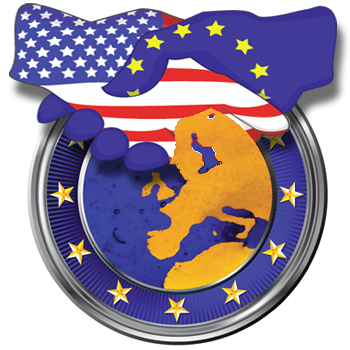Transatlantic Trade and Investment Partnership (TTIP): EU/U.S. Relations & Emerging Markets
A TTIP discussion with Prof. Thomas Wimmer, chairman of the executive board of BVL, Germany’s 10,000-member logistics association, and Kim Pedersen, EVP of Geodis Wilson.
TTIP to be a driving force in EU/U.S. relations
Prof. Thomas Wimmer, chairman of the executive board of BVL, Germany’s 10,000-member logistics association, is convinced that the pending Transatlantic Trade and Investment Partnership (TTIP) will be a driving force for the logistics industry.

But he also sees a need to strengthen the infrastructure and create a framework for high performance logistics on both sides of the Atlantic.
Dagmar Trepins: How do you think the Transatlantic Trade and Investment Partnership (TTIP) could boost trade between the U.S. and Europe? What are your expectations concerning the logistics industry?
Thomas Wimmer: The TTIP is designed to reduce trade barriers, simplify approval and certification, and standardization processes. When implemented, this is naturally expected to generate major stimuli both in Germany and in the US.
The agreement opens up new markets for both sides and could also pave the way for the definition of more technical and technological standards, creating new opportunities for the development of even more efficient value added supply chains.
Provided that agreement is reached on uniform conditions for data protection and the transmission of data, this could also greatly increase transparency in supply chains. This would, in turn, positively affect efficiency and flexibility.
Certainty of action in this area is also important for the future development of cloud computing. Whether and to what extent these opportunities will be grasped, however, depends on how intelligently the treaty is formulated.
Trepins: What are the biggest challenges that face Europe’s logistics industry and what is your outlook for the rest of 2013?
Wimmer: The biggest challenges for logistics, and not only in Europe, include increasing complexity, the pressure of costs, ever-increasing customer expectations, and the lack of skilled employees and qualified personnel for the future.
In today’s world, logistics takes place in global networks, and the global division of labor between more or less stable players means we have to cope with a high level of volatility. This is particularly evident if we look back at the last five years.
According to the findings of the latest BVL study Trends and Strategies in Logistics and Supply Chain Management, these trends will continue to shape logistics in the coming years.
An area of further concern is infrastructure. Future success depends on an efficient infrastructure in Europe that ensures mobility not only for people and goods, but also for information and services.
One example for the urgent need for action in this area is the manufacturing industry. Over the last 10 years, growing specialization, geographic relocation of production processes, and changes in consumer behavior have resulted in an over 30 percent increase in freight transport volumes throughout the EU.
In order to create the framework for high-performance logistics, it is also important—particularly in the EU—that uniform conditions are put in place with regard to qualification and personnel as well as in the area of national regulations.
While TTIP will open doors, providers can’t take eyes off emerging markets
Since turning the global freight management company’s sites on trade between Europe and the U.S., Geodis Wilson’s executive vice president Kim Pedersen says he’s bullish on TTIP.

However, he also sees a need to respond to a situation in which future growth will be coming from the emerging countries.
Dagmar Trepins: The first round of Transatlantic Trade and Investment Partnership (TTIP) negotiations has taken place. How do you think it could boost trade between the U.S. and Europe?
Kim Pedersen: The first round mainly covered areas such as energy, raw materials, agricultural goods, and also intellectual property rights, and it was all about identifying the potential benefits for both economical areas.
Of course any additional dynamic here would subsequently show its benefits for the transportation sector as well, but it’s too early to comment.
The second round of negotiations, scheduled for October, might reveal more details. For sure we can say that we are following the debate with interest, as the trade from and to the U.S. in one of our focus areas.
Trepins: How have problems in the Eurozone affected your business in Europe and what is your outlook for 2013
and beyond?
Pedersen: Triggered by the economical stagnation in a number of Euro-countries, we have been experiencing a slowdown in the regional transport market for more or less four years, with a few positive interruptions in between.
However, I would like to avoid labeling this as a crisis. What we are experiencing is a “new normal,” as I would describe it. We won’t come back to a situation similar to before 2008 when everybody was expecting endless growth in the transport flows.
When we talk to our clients, they indicate that the development in the foreseeable future will most likely remain flat in Europe. However, there is still plenty of growth out there, it’s just moving to other regions such as Russia, China, India, Brazil, as well as Mexico and Indonesia.
These are the markets that on-boarded much of the volumes we have previously handled in Europe. So, it’s an obligation as a global transport company to adapt to this situation—or even to take part in designing it, which we certainly do with our international development strategy.
Trepins: How has your business developed in the U.S. market?
Pedersen: We have ambitious development targets in this key market, and the signs are all positive. Just recently, our industrial projects unit in Houston signed a new 45 million euro logistics contract with a major oil and gas player, and also in other segments such as automotive and fashion we are making quick progress, for instance with our store opening logistics service.













